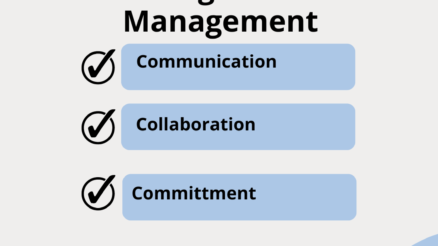Have you ever experienced a sudden and unexpected shift in the way things work in your industry or business?
One moment everything seems stable and predictable, and the next, new technologies, changing consumer behaviors, or global events disrupt the status quo.
This kind of disruptive change has been a constant force throughout human history, from the invention of the printing press to the rise of the internet.
While disruptive change can create enormous opportunities and benefits, it can also be challenging for businesses and individuals who are unprepared.
In this article, we’ll discuss the concept of disruption in business, its causes and effects, and disruptive change examples.
Let’s dive in.
What is Disruptive Change in Business?
Disruptive change refers to a sudden and significant shift in the way things work in a particular industry or society as a whole.
This type of change can be driven by various factors, such as technological advancements, changes in consumer behavior, or global events.
Disruptive change often creates new markets, products, or services, and can lead to the displacement of established players in the industry.
It differs from incremental change, which involves gradual and minor improvements to existing products or services.
Disruptive change can have significant impacts on businesses, consumers, and society as a whole, and can create both opportunities and challenges.
Disruptive Change Vs Incremental Change
Disruptive change often involves the introduction of new technologies, business models, or products that disrupt the status quo and create new opportunities for businesses and consumers.
Disruptive change examples include the introduction of the internet, the rise of e-commerce, and the emergence of ride-sharing services.
Incremental change, on the other hand, refers to a series of small and gradual changes that are made over time. Incremental change is often focused on improving existing products or services, streamlining processes, or making minor adjustments to business strategies.
Examples of incremental change include making small improvements to a product, introducing new features to an existing service, or refining a marketing strategy.
While both disruptive change and incremental change can be beneficial for businesses, they have different strengths and weaknesses. Disruptive change can create new markets and opportunities, but it can also be risky and disruptive to established businesses.
Incremental change is typically less risky and more manageable, but it may not result in significant changes to the overall business or industry.
Characteristics of Disruptive Change
Disruptive change has several key characteristics that set it apart from other types of change. Understanding these characteristics of disruptive change is important for businesses and individuals to adapt and respond effectively to these types of changes in their industries or society.
These characteristics include:
Disruptive change is often unexpected
Disruptive change can happen quickly and catch people by surprise. This is because it is often driven by emerging technologies, changing consumer behavior, or global events that are difficult to predict.
Disruptive change creates new markets
Disruptive change often leads to the creation of new markets or the expansion of existing ones. This is because it introduces new products or services that meet unmet or previously unknown needs.
Disruptive change can disrupt established players
Disruptive change can be challenging for established players in an industry. This is because it can lead to the displacement of existing products or services, or the emergence of new competitors that disrupt the status quo.
Disruptive change can be initially inferior
Disruptive change can start out as inferior to established products or services in terms of quality or performance. However, it can improve rapidly and eventually overtake the established players.
Disruptive change can have significant societal impacts
Disruptive change can have far-reaching impacts on society as a whole, beyond just the industry or market it disrupts. This is because it can change the way people live, work, and interact with each other.
Driving Factors for Disruptive Change
Disruptive change can be driven by various factors, including:
Technological advancements
Technological advancements can be a major driver of disruptive change. The emergence of new technologies or the improvement of existing ones can create new markets and products, or improve existing ones. For example, the rise of smartphones and mobile apps has disrupted traditional industries like print media and retail.
Changes in consumer behavior
Changes in consumer behavior can also lead to disruptive change. This can include shifts in preferences, values, or expectations. For example, the rise of e-commerce and online shopping has disrupted traditional brick-and-mortar retail, as consumers increasingly prefer the convenience and flexibility of online shopping.
Global events
Global events, such as economic crises or geopolitical shifts, can also drive disruptive change. These events can create new opportunities or challenges for businesses and industries, and require them to adapt in order to survive. For example, the COVID-19 pandemic has accelerated the adoption of remote work and e-commerce, while also disrupting traditional industries like travel and hospitality.
Regulatory changes
Regulatory changes can also drive disruptive change, as they can create new opportunities or constraints for businesses and industries. For example, the adoption of new environmental regulations can create new markets for renewable energy and green technologies, while also disrupting traditional fossil fuel industries.
Benefits of Disruptive Change
Disruptive change can create numerous benefits for businesses, consumers, and society as a whole. Some of the benefits of disruptive change include:
- Innovation: Disruptive change can stimulate innovation and the development of new products, services, and business models. It can encourage businesses to think creatively and find new ways to meet customer needs and solve problems.
- Increased competition: Disruptive change can increase competition within an industry, which can lead to better products and services, lower prices, and greater consumer choice. This can benefit consumers by giving them more options and better value for their money.
- Economic growth: Disruptive change can drive economic growth by creating new markets, products, and services, and by encouraging entrepreneurship and investment. It can also lead to job creation, as new businesses and industries emerge.
- Social and environmental benefits: Disruptive change can have social and environmental benefits by creating new solutions to societal challenges, such as climate change or income inequality. For example, the rise of renewable energy technologies has the potential to mitigate the impacts of climate change and create a more sustainable future.
Potential Risks of Disruptive Change
Disruptive change can also pose several risks and challenges for businesses, consumers, and society. Some of the potential risks of disruptive change include:
- Disruption to established businesses: Disruptive change can pose a significant threat to established businesses and industries. This can lead to the displacement of existing products or services, or the emergence of new competitors that disrupt the status quo.
- Job displacement: Disruptive change can lead to job displacement and unemployment, as businesses and industries are forced to adapt or close down. This can have significant social and economic impacts, particularly for workers who are unable to find new employment.
- Social and economic inequality: Disruptive change can exacerbate social and economic inequality, particularly if certain individuals or groups are disproportionately impacted by job displacement or other negative effects of disruptive change.
- Resistance to change: Disruptive change can be challenging for individuals and organizations who are resistant to change or who are unable to adapt quickly enough. This can lead to missed opportunities or the failure to compete effectively in the face of disruptive change.
- Ethical concerns: Disruptive change can raise ethical concerns, particularly if it involves the use of emerging technologies that are not yet fully understood or regulated. For example, the rise of artificial intelligence and automation raises questions about the impact on privacy, security, and human autonomy.
Disruptive Change Examples
Here are some of disruptive change examples and how they affected the business:
- Amazon’s e-commerce platform: Amazon’s entry into the e-commerce market disrupted traditional brick-and-mortar retail, forcing many businesses to adapt to the online retail environment or risk being left behind.
- Uber and ride-sharing services: Uber and other ride-sharing services disrupted traditional taxi and transportation businesses, creating a new market for peer-to-peer transportation and challenging traditional business models.
- Airbnb: Airbnb disrupted the hotel industry by offering a platform for individuals to rent out their homes or apartments as short-term rentals, challenging traditional hotel business models.
- Netflix: Netflix disrupted the traditional television and film industry by offering a streaming service that allowed customers to watch content on-demand, challenging traditional cable and broadcast business models.
- Apple’s iPhone: The iPhone disrupted the mobile phone industry by introducing a new type of smartphone that combined various technologies, such as music players and cameras, into one device, changing the way people use their phones and disrupting traditional phone business models.
- Tesla’s electric cars: Tesla disrupted the automobile industry by introducing a new type of electric car that combined luxury features with environmentally-friendly technology, challenging traditional fossil fuel-based car business models.
- Google search engine: Google’s search engine disrupted traditional methods of finding information, making it easier and faster for people to find the information they need, and disrupting traditional print and online media business models.
- 3D printing: 3D printing disrupted traditional manufacturing processes by allowing businesses and individuals to create products on-demand, changing the way products are designed, produced, and distributed.
- Blockchain technology: Blockchain technology disrupted traditional financial systems by offering a decentralized and secure way to store and transfer data, challenging traditional banking business models.
- Social media platforms: Social media platforms, such as Facebook and Twitter, disrupted traditional methods of communication and marketing, creating new opportunities for businesses to engage with customers and reach new audiences, and challenging traditional advertising and marketing business models.
How to Manage Disruptive Change at Organization
Managing disruptive change can be a complex and challenging task, but there are several strategies that businesses can use to help navigate these changes effectively. Learning from disruptive change examples and adopting following effective strategies, businesses can manage disruptive change and position themselves for success in an ever-changing market
Here are some key ways to manage disruptive change:
- Stay informed: Businesses need to stay up-to-date on the latest trends and technologies within their industry to anticipate and prepare for disruptive changes.
- Be proactive: Rather than waiting for change to happen, businesses should take a proactive approach to innovation and explore new opportunities for growth.
- Embrace agility: To manage disruptive change, businesses need to be flexible and adaptable. They should be prepared to pivot quickly in response to new challenges and opportunities.
- Build a strong team: Managing disruptive change requires a team with diverse skills and expertise. Businesses should build a team that is agile, innovative, and able to think outside the box.
- Encourage innovation: Businesses should foster a culture of innovation and encourage employees to explore new ideas and technologies.
- Develop a strategic plan: Businesses should develop a strategic plan that outlines their goals and objectives, as well as the steps they will take to achieve them.
- Invest in technology: To stay ahead of disruptive change, businesses need to invest in the latest technologies and tools that can help them remain competitive.
- Collaborate with others: Businesses can benefit from collaborating with other businesses and organizations that are also adapting to disruptive change. This can help them share resources, knowledge, and best practices.
- Monitor progress: Businesses should regularly monitor their progress and adjust their strategies as needed. This will help them stay on track and continue to adapt to disruptive change.
Final Words
Disruptive change can be both a challenge and an opportunity for businesses. While it can bring risks and uncertainty, it also has the potential to create new markets, opportunities, and competitive advantages. Embracing innovation, staying informed, being proactive, and investing in technology and strategic planning can help businesses navigate disruptive change and stay ahead of the curve in a rapidly evolving market. Disruptive change examples also explains what kind of business adopted disruptions and inspired others to follow them.



